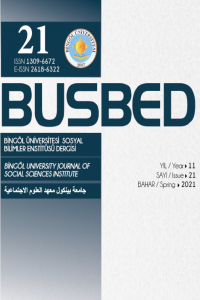OSMANLI İŞÇİ TARİHİNE BİR BAKIŞ: THE ORIENTAL CARPET MANUFACTURERS LIMITED’İN [ŞARK HALI KUMPANYASI] ÜRETİM ORGANİZASYONU, İŞÇİLERİ VE ÜCRET POLİTİKASI [1908 – 1914]
Öz
Bu araştırma, 16 Aralık 1907 tarihinde Londra’da kurulup tüzel bir kişilik kazanan The Oriental Carpet Manufacturers Limited [OCM] veya diğer bir ismiyle Şark Halı Kumpanyası’nın 20. yüzyılın başında kuruluşuna giden süreci ve şirketin kuruluşuyla beraber Anadolu coğrafyasında 1908 yılından itibaren uyguladığı eve iş verme sistemini [putting – out ] ne şekilde organize ettiğini açıklamayı amaçlamaktadır. Araştırmamız ayrıca şirketin eve iş verme sistemi dâhilinde yürüttüğü halı üretim faaliyetleri sonucu Anadolu coğrafyasında istihdam ettiği, ettirdiği halı dokuma işçilerinin sayısını tespit edip, uygulanan ücret politikasını ve halı dokuma işçilerinin çalışma koşullarını ele alarak Osmanlı imalat sektörünün önemli üretim alanlarından biri olan halıcılığın Osmanlı işçi tarihindeki önemini incelemektedir. 1908’den 1914 yılına kadar sadece Anadolu coğrafyasında 50 – 60 bin arasında halı dokuma işçisi istihdam edip eve iş verme sistemi sayesinde kayda değer kârlar elde eden OCM, bu yönüyle Osmanlı halıcılığını monopolize etmiş ve I. Dünya Savaşı’nın hemen öncesine kadar halı üretim faaliyetlerini devam ettirerek aynı zamanda Anadolu - Osmanlı halılarının en önemli ihracatçılarından biri olmuştur.
Anahtar Kelimeler
Kaynakça
- 1- St. Antony’s College Middle East Centre Archive Oriental Carpet Manufacturers Ltd Collection [SAC MECA OCM COL]
- SAC MECA OCM COL, Kutu: 1, No: 2, The Oriental Carpet Manufacturers Ltd, Ordinary General Meeting of the 9th March 1909.
- SAC MECA OCM COL, Kutu: 1, No: 2, The Oriental Carpet Manufacturers Ltd, Ordinary General Meeting of the 16th February 1910.
- SAC MECA OCM COL, Kutu: 1, No:2, The Oriental Carpet Manufacturers Ltd, Ordinary General Meeting of the 28th March 1911.
- SAC MECA OCM COL, Kutu: 1, No: 2, The Oriental Carpet Manufacturers Ltd, Ordinary General Meeting of the 17th April 1912.
- SAC MECA OCM COL, Kutu: 1, No: 2, The Oriental Carpet Manufacturers Ltd, Ordinary General Meeting of the 27th June 1913.
- SAC MECA OCM COL, Kutu: 1, No: 2, The Oriental Carpet Manufacturers Ltd, Ordinary General Meeting of the 10th November 1920.
- SAC MECA OCM COL, Kutu: 1, No: 2, The Oriental Carpet Manufacturers Ltd, Ordinary General Meeting of the 27th July 1921.
- SAC MECA OCM COL, Kutu: 3, No: 10, Production des Agents & Agences de L’Interieur.
- SAC MECA OCM COL, Kutu: 3, No: 11, Production des Agents & Agences de L’Interieur D’Apres Les Provenances.
- SAC MECA OCM COL, Kutu: 3, No: 5, Matthew Lee, History of The Oriental Carpet Manufacturers Ltd.
A LOOK AT THE HISTORY OF OTTOMAN LABOUR: PRODUCTION ORGANIZATION, WORKERS AND WAGE POLICY OF THE ORIENTAL CARPET MANUFACTURERS LIMITED [ŞARK HALI KUMPANYASI] [1908 – 1914]
Öz
This study aims to explain the process of The Oriental Carpet Manufacturers Limited [OCM] or aka Şark Halı Kumpanyası founded in London on December 16, 1907 and acquired a legal personality from the beginning of the 20th century to its establishment and how the company has organized the home-employment system [putting – out ] it has been implementing in the Anatolian geography since 1908. Our study also determines the number of carpet weaving workers that the company has employed in the Anatolian geography as a result of the carpet production activities carried out within the home employment system, and it examines the importance of carpet weaving, which is one of the important production areas of the Ottoman manufacturing sector, in the history of Ottoman workers by considering the wage policy applied and the working conditions of carpet weaving workers. From 1908 until 1914, OCM employed 50 - 60 thousand carpet weaving workers in Anatolia alone and made significant profits thanks to the home employment system, it monopolized the Ottoman carpet weaving in this respect and at the same time it became one of the most important exporters of Anatolian - Ottoman carpets by continuing its carpet production activities until just before the First World War.
Anahtar Kelimeler
Kaynakça
- 1- St. Antony’s College Middle East Centre Archive Oriental Carpet Manufacturers Ltd Collection [SAC MECA OCM COL]
- SAC MECA OCM COL, Kutu: 1, No: 2, The Oriental Carpet Manufacturers Ltd, Ordinary General Meeting of the 9th March 1909.
- SAC MECA OCM COL, Kutu: 1, No: 2, The Oriental Carpet Manufacturers Ltd, Ordinary General Meeting of the 16th February 1910.
- SAC MECA OCM COL, Kutu: 1, No:2, The Oriental Carpet Manufacturers Ltd, Ordinary General Meeting of the 28th March 1911.
- SAC MECA OCM COL, Kutu: 1, No: 2, The Oriental Carpet Manufacturers Ltd, Ordinary General Meeting of the 17th April 1912.
- SAC MECA OCM COL, Kutu: 1, No: 2, The Oriental Carpet Manufacturers Ltd, Ordinary General Meeting of the 27th June 1913.
- SAC MECA OCM COL, Kutu: 1, No: 2, The Oriental Carpet Manufacturers Ltd, Ordinary General Meeting of the 10th November 1920.
- SAC MECA OCM COL, Kutu: 1, No: 2, The Oriental Carpet Manufacturers Ltd, Ordinary General Meeting of the 27th July 1921.
- SAC MECA OCM COL, Kutu: 3, No: 10, Production des Agents & Agences de L’Interieur.
- SAC MECA OCM COL, Kutu: 3, No: 11, Production des Agents & Agences de L’Interieur D’Apres Les Provenances.
- SAC MECA OCM COL, Kutu: 3, No: 5, Matthew Lee, History of The Oriental Carpet Manufacturers Ltd.
Ayrıntılar
| Birincil Dil | Türkçe |
|---|---|
| Bölüm | Araştırma Makaleleri |
| Yazarlar | |
| Yayımlanma Tarihi | 27 Nisan 2020 |
| Yayımlandığı Sayı | Yıl 2021Sayı: 21 |



